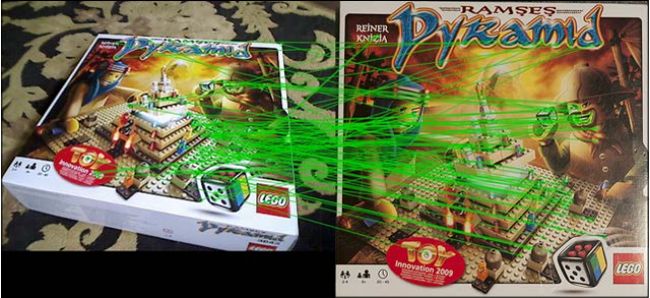学习OpenCV——KeyPoint Matching 优化方式
今天读Mastering OpenCV with Practical Computer Vision Projects 中的第三章里面讲到了几种特征点匹配的优化方式,在此记录。
在图像特征点检测完成后(特征点检测参考:学习OpenCV——BOW特征提取函数(特征点篇)),就会进入Matching procedure。
1. OpenCV提供了两种Matching方式:
• Brute-force matcher (cv::BFMatcher)
• Flann-based matcher (cv::FlannBasedMatcher)
Brute-force matcher就是用暴力方法找到点集一中每个descriptor在点集二中距离最近的descriptor;
Flann-based matcher 使用快速近似最近邻搜索算法寻找(用快速的第三方库近似最近邻搜索算法)
一般把点集一称为 train set (训练集)对应模板图像,点集二称为 query set(查询集)对应查找模板图的目标图像。
为了提高检测速度,你可以调用matching函数前,先训练一个matcher。训练过程可以首先使用cv::FlannBasedMatcher来优化,为descriptor建立索引树,这种操作将在匹配大量数据时发挥巨大作用(比如在上百幅图像的数据集中查找匹配图像)。而Brute-force matcher在这个过程并不进行操作,它只是将train descriptors保存在内存中。
2. 在matching过程中可以使用cv::DescriptorMatcher的如下功能来进行匹配:
- 简单查找最优匹配:void match(const Mat& queryDescriptors, vector<DMatch>& matches,const vector<Mat>& masks=vector<Mat>() );
- 为每个descriptor查找K-nearest-matches:void knnMatch(const Mat& queryDescriptors, vector<vector<DMatch> >& matches, int k,const vector<Mat>&masks=vector<Mat>(),bool compactResult=false );
- 查找那些descriptors间距离小于特定距离的匹配:void radiusMatch(const Mat& queryDescriptors, vector<vector<DMatch> >& matches, maxDistance, const vector<Mat>& masks=vector<Mat>(), bool compactResult=false );
3. matching结果包含许多错误匹配,错误的匹配分为两种:
- False-positive matches: 将非对应特征点检测为匹配(我们可以对他做文章,尽量消除它)
- False-negative matches: 未将匹配的特征点检测出来(无法处理,因为matching算法拒绝)
为了消除False-positive matches采用如下两种方式:
- Cross-match filter:
在OpenCV中 cv::BFMatcher class已经支持交叉验证,建立
cv::BFMatcher将第二参数声明为true
cv::Ptr<cv::DescriptorMatcher> matcher(new cv::BFMatcher(cv::NORM_HAMMING,true));
经过
Cross-match filter的结果:
- Ratio test
使用KNN-matching算法,令K=2。则每个match得到两个最接近的descriptor,然后计算最接近距离和次接近距离之间的比值,当比值大于既定值时,才作为最终match。
void PatternDetector::getMatches(const cv::Mat& queryDescriptors, std::vector<cv::DMatch>& matches)
{
matches.clear();
if (enableRatioTest)
{
// To avoid NaNs when best match has
// zero distance we will use inverse ratio.
const float minRatio = 1.f / 1.5f;
// KNN match will return 2 nearest
// matches for each query descriptor
m_matcher->knnMatch(queryDescriptors, m_knnMatches, 2);
for (size_t i=0; i<m_knnMatches.size(); i++)
{
const cv::DMatch& bestMatch = m_knnMatches[i][0];
const cv::DMatch& betterMatch = m_knnMatches[i][1];
float distanceRatio = bestMatch.distance /
betterMatch.distance;
// Pass only matches where distance ratio between
// nearest matches is greater than 1.5
// (distinct criteria)
if (distanceRatio < minRatio)
{
matches.push_back(bestMatch);
}
}
}
else
{
// Perform regular match
m_matcher->match(queryDescriptors, matches);
}
}
4. Homography estimation
为了进一步提升匹配精度,可以采用随机样本一致性(RANSAC)方法。
为了进一步提升匹配精度,可以采用随机样本一致性(RANSAC)方法。
因为我们是使用一幅图像(一个平面物体),我们可以将它定义为刚性的,可以在pattern image和query image的特征点之间找到单应性变换(homography transformation
)。使用cv::findHomography找到这个单应性变换,使用RANSAC找到最佳单应性矩阵。(由于这个函数使用的特征点同时包含正确和错误匹配点,因此计算的单应性矩阵依赖于二次投影的准确性)
bool PatternDetector::refineMatchesWithHomography
(
const std::vector<cv::KeyPoint>& queryKeypoints,
const std::vector<cv::KeyPoint>& trainKeypoints,
float reprojectionThreshold,
std::vector<cv::DMatch>& matches,
cv::Mat& homography
)
{
const int minNumberMatchesAllowed = 8;
if (matches.size() < minNumberMatchesAllowed)
return false;
// Prepare data for cv::findHomography
std::vector<cv::Point2f> srcPoints(matches.size());
std::vector<cv::Point2f> dstPoints(matches.size());
for (size_t i = 0; i < matches.size(); i++)
{
srcPoints[i] = trainKeypoints[matches[i].trainIdx].pt;
dstPoints[i] = queryKeypoints[matches[i].queryIdx].pt;
}
// Find homography matrix and get inliers mask
std::vector<unsigned char> inliersMask(srcPoints.size());
homography = cv::findHomography(srcPoints,
dstPoints,
CV_FM_RANSAC,
reprojectionThreshold,
inliersMask);
std::vector<cv::DMatch> inliers;
for (size_t i=0; i<inliersMask.size(); i++)
{
if (inliersMask[i])
inliers.push_back(matches[i]);
}
matches.swap(inliers);
return matches.size() > minNumberMatchesAllowed;
}

